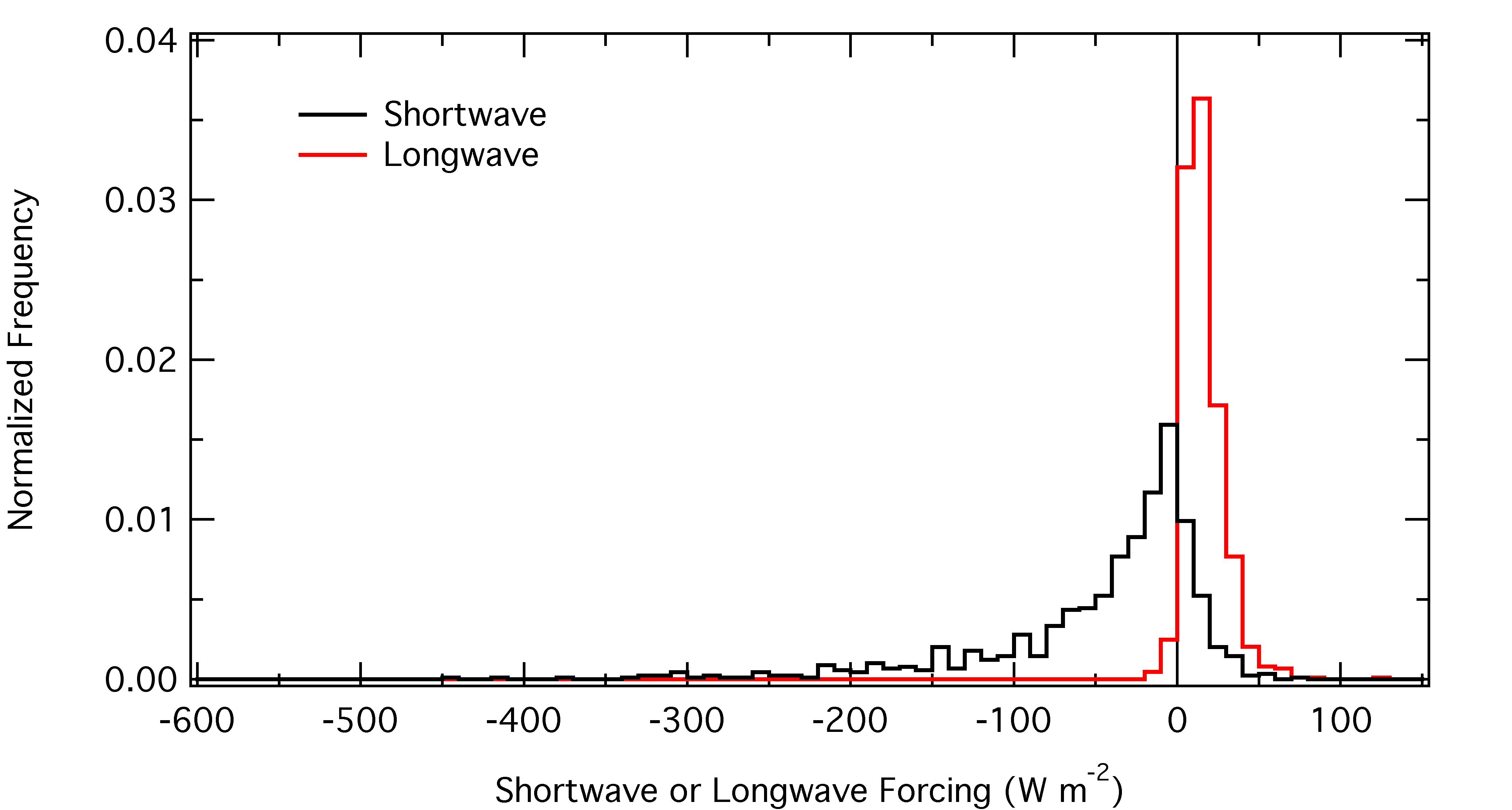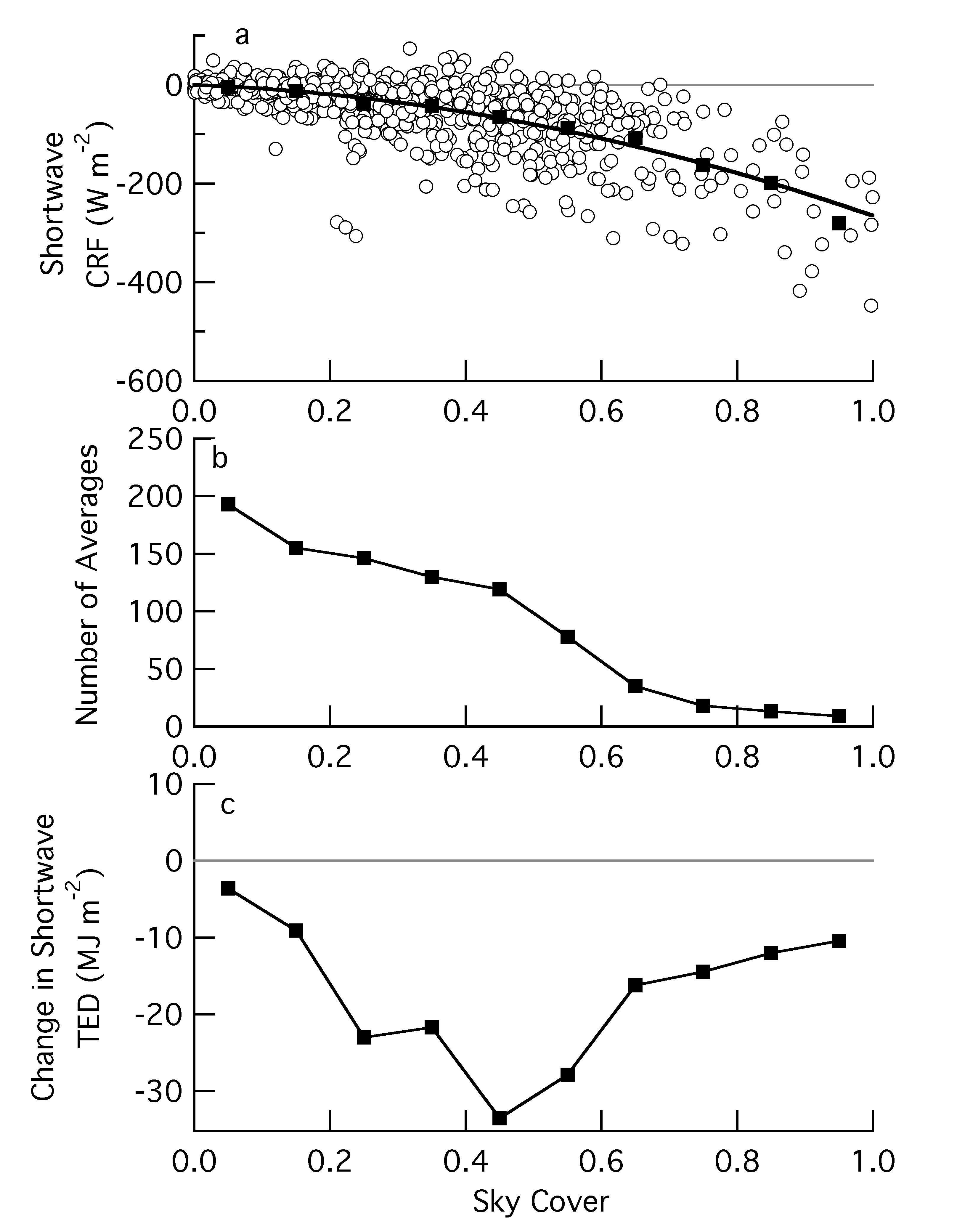Surface Summertime Radiative Forcing by Shallow Cumuli at the ARM SGP
Submitter:
Berg, Larry — Pacific Northwest National Laboratory
Area of research:
Radiation Processes
Journal Reference:
Science
Fair-weather cumuli are ubiquitous, occurring over large portions of both the continents and trade wind regions of the oceans, and have a substantial impact on the surface radiation budget. Compared to other cloud types, cumulus properties have large variations in both time and space, and these variations are poorly captured by current large-scale models.
A number of studies have documented the cloud amount associated with shallow cumuli over the central United States, but these studies did not investigate the shortwave or longwave cloud radiative forcing (CRF) associated with these clouds. Several short-duration field campaigns were performed recently that were designed to investigate various aspects of the life cycle of shallow cumuli. The study presented here represents a multi-year climatology of cumulus radiative properties that utilizes a high-resolution time series of sky cover and surface fluxes collected during eight summers (2000-2007) at the U.S. Department of Energy Atmospheric Radiation Measurement (ARM) Climate Research Facility Southern Great Plains (SGP) site. We use these time series to address three questions:
1. How large are contributions of the shortwave and longwave components to the net CRF at the surface?
2. What is the magnitude and observational frequency of the positive shortwave CRF at the surface?
3. What is the relationship between the sky cover and the total amount of shortwave and longwave energy deposited at the surface over a period of time?
Impact
The summertime averages of the shortwave and longwave components of the hourly average CRF at the surface are found to be -45.5 W m-2 (out of 612 W m-2 for clear sky conditions) and 15.9 W m-2 (out of -105 W m-2 for clear sky conditions), respectively. Thus, the shortwave component is nearly three times larger than its longwave counterpart, and the presence of shallow cumuli lead to a net cooling of the surface. Both the hourly average shortwave and longwave CRF were found to increase in magnitude with increasing cloud fraction. The inhomogeneity of the cumulus properties is responsible for many cases with positive shortwave CRF, which are associated with cloud-induced enhancement of the diffuse irradiance. For such cases, the cloudy-sky instantaneous values of the diffuse irradiance can exceed the corresponding instantaneous clear-sky values by as much as 225 W m-2. The positive and negative components of the shortwave CRF are characterized by small-scale fluctuations; about 95% of them are less than 20-minute duration. In comparison with the positive component of shortwave CRF, the negative component has larger amplitude (up to 800 W m-2). Although temporal averaging reduces the amplitude of the positive CRF and its population, nearly 20% of all 1-hr averages of CRF were positive. The neglect of the positive component of the forcing would increase the summertime average CRF by nearly 24% (from 45.5 W m-2 to -59.5 W m-2), The total amount of shortwave and longwave energy deposited at the surface (TED) is the amount of energy that is available for partitioning between sensible, latent, and soil heat flux. Both the change in shortwave TED and the change in the longwave TED have a non-linear dependence on the fractional sky cover, with the largest values occurring at intermediate sky cover. Two competing factors lead to this behavior of the shortwave and longwave TED. The first factor is the magnitude of CRF, which increases with increasing sky cover. The second factor is the number of occurrences of any cloud amount, which, for shallow cumuli, decreases with increasing sky cover. These two competing factors lead to the observed non-linear behavior of the shortwave and longwave TED.
Summary
Small and optically thin shallow cumuli are frequently observed over land and ocean. The geometrical and optical properties of cumulus clouds exhibit large variations over both time and space and lead to a large amount of variability of the radiative properties at the surface. This study describes the impact of shallow cumuli on the shortwave and longwave components of the CRF at the surface using data collected during eight summers at the ARM SGP site. While the observed quantitative impact on the surface CRF is representative of local conditions at the study site, the qualitative impact, namely the important role of shallow cumuli in the Earth’s surface energy budget, is expected to be applicable at a wide range of locations around the globe. In addition, the data set developed as part of this study is a useful tool for evaluating models of the atmosphere.



